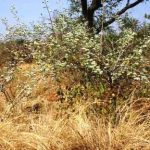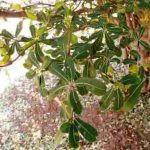TREE LIFE
November 1996
We all congratulate Meg Coates Palgrave on being chosen Conservationist of the Year, and being the recipient of the Bob Rutherford Memorial Award. We are proud and happy that a ‘Tree Person’ is this year’s winner.
MASHONALAND CALENDAR
Tuesday 5th November: Botanic Garden Walk at 4.45 for 5 p.m. We will meet Tom in the public car park of the Gardens. Tom will be discussing the Strychnos species especially those which occur in Zimbabwe. A list will be distributed at the walk. There will be a guard for the cars.
Sunday 17th November: Our outing to a really lovely spot on one of the tributaries of the Manyame River in the Umboe/Raffingora area is one of the most distant trips from Harare that we have ventured on this year. However it is an idyllic spot with some truly massive specimens of Khaya anthotheca, Celtis africana and Diospyros mespiliformis in the riverine forest, which offers very easy walking along the river. We hope also that this will be “Ayrshire Members’ Day” and we look forward to meeting them again.
Saturday 23rd November: Mark’s Walk will be in Hillside Park, a site unknown to me, which Maureen, Andy and I explored after the crucifer walk in October. To get there drive south along Glenara Avenue South from the turning to the Mukuvisi Woodlands. After about 1km, turn into Helm road, which is merely a dirt track going off to the right. After about 0.5km, turn left into Hillside Park and we will meet c.400 m further on at 2.30 p.m.
Tuesday 3rd December. Botanic Garden walk
MATABELELAND CALENDAR
Friday 1st to Sunday 3rd November: To Tom and Mary Raub’s Kana Estate near Gwayi.
Monday 11th November: Urban trails in Circular Drive area. Meeting at 5-5.15 p.m. These sessions will take place on the second Monday of every month on a regular basis.
Sunday 1st December: Visit to Brownlee-Walkers farm at Shangani.
New Year’s Social Do: Possibly at Clem Van Vliet’s or at Mabukuwene Aloe Garden.
BOTANIC GARDEN WALK 1 OCTOBER 1996
The subject for Tom’s walk was the genus Hippocratea or rather, the former genus as it has now been fragmented into 5 genera. To assist those attending, a list of the Zimbabwean species had been prepared and printed on the back of Tree Life. Maureen had also brought along a supply of copies.
Hippocratea belongs to the Celastraceae. Ten species have been recorded from Zimbabwe and they have the following features in common:
• they are mainly lowveld or rainforest species
• generally they are climbing or scrambling plants, sometimes ? shrubs, while others are gigantic lianas
• the leaves are opposite
• branching is opposite and decussate
• the fruit, arranged in threes, consists of flattened capsules (hence the common name Paddle-pods)
• the seeds are flattened and winged
• the lateral branches are used as aids to climbing, often coiling into tendril-like structures around other vegetation.
The genus Hippocratea forms a reasonably compact and recognisable group and there was surprise that it had been split into other genera.
The first taxon examined was Loeseneriella crenata (Hippocratea crenata). Tom explained that it is quite common in the lowveld, occurring along dried up streams and also in the jesse. The leaves are generally crenate (but variably so) and are small.
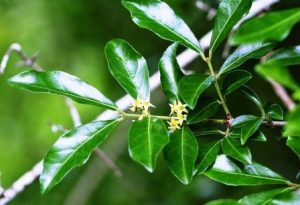
Hippocratea crenata. Photo: Bart Wursten. Source: Flora of Zimbabwe
Next – Reissantia buchananii (Hippocratea buchananii) this species was more of a shrub with a soft hairy leaf; rather different to the more glossy coriaceous leaves of most of the species we saw. The leaves are also relatively large. Tom explained that it is never common. It occurs in the lowveld and specifically in the escarpment area. Pristimera longipetiolata (Hippocratea longipetiolata) does have longish petioles but not strikingly so. It has a narrow long leaf and is usually a climber. Very tiny flowers were found on this specimen. Its habitat is dry river banks.
Tom remarked how some Hippocratea spp. and other Celastraceae have an orange slash. He recounted how uncomfortable Blake Goldsmith was made by Tom slashing at the tree trunks.
Loeseneriella africana var. richardiana (Hippocratea africana var. richardiana) is a climber in riverine forest and also a forest liana. It is one of the main climbers in the Chirinda Forest.
Elachyptera parvifolia is quite like Loeseneriella africana in appearance but differs in habitat in that it not only in riverine or rainforest habitats, but extends to woodland and rocky outcrops. It is also a climber and mostly in the lowveld.
Reissantia parviflora with a similar sounding specific name is a very rare species, never seen by Tom, and not represented in the Gardens.
How do the 5 genera differ? From the key to East African species, floral characteristics are mostly used and specifically the arrangement of the petals in bud, the shape of the disc and the presence or absence of a style.
Hippocratea sp. no. 1, collected by Tom and referred to in Tree Life 200, had turned out to have berries and was actually a species of Salacia (also Celastraceae).
To sum up, one’s impression was of a quite difficult genus, not easily identified to species when in leaf. Once again, our thanks to Tom for a fascinating walk. Obviously it was of a somewhat specialist nature, which Tom remarked does not appeal to everyone. However, it was agreed that next month a similar approach would be followed and the genus Strychnos would be studied. Again, a list of the Zimbabwean species will be available at the meeting.
-Mark Hyde
IMIRE GAME PARK 18 AUGUST 1996
A thatched bush camp sheltering in the shade of a large Acacia galpinii and a number of Acacia karroo, faces a prominent kopjie and is in an area steeped in archaeological history.
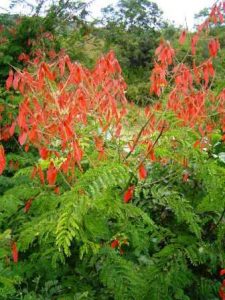
Pterolobium stellatum. Photo: Bart Wursten. Source: Flora of Zimbabwe
Prior to actually looking at the site, an excellent talk by Rob Burrett detailed who the people were and how they lived, their trade through northern Mashonaland and even how their deceased chiefs were preserved. Something to watch out for on kopjies such as these are the great tangles of the robust climber Pterolobium stellatum – the strong hooks grapple anything that passes and the beautiful red flat seeds are only a disguise to trick passers-by. Douglas and I spent a few happy minutes trying to hook each other in it, testing out a theory of the plant having excellent defence. An artefact under this particular spiny bush, a piece of footwear, bore an inscription on the underside – BATA.
The excavation of sites on the kopjie in the early 1980’s by Corona Thornycroft revealed a series of layers or remnants of ‘refuge’ left by each of the cultures. They occupied the site starting with the early Harare period, carbon dated to about 1270 AD, followed by a more exciting, for archaeologists, Zimbabwe period and nearest to the surface a much later period of Harare artefacts. Of even more importance, the excavations at the entrance to the cave revealed the remains of a young female figure. She was evidently of noble birth for two gold wire bracelets still dangled on the crossed arm bones, copper and iron bangles on the legs along with 170 gold beads in her burial chamber. Perhaps she was a princess of the Sosve culture who occupied the area from c.1740 who traded in agricultural goods, gold and iron. The presence of some gold smelting crucibles deep within the cave guarded by the tangle of inquisitive roots from a Ficus thonningii, certainly reinforce the idea of the Sosve people having had control of the area, the Makwe Caves, a few kilometres away from the burial site for their chiefs.
During a discussion about the practice of the Sosve smoking their deceased chiefs prior to internment, a large shaggy Nyala ram suddenly appeared out of the long grass to investigate the feed bin before heading back to the thickets. These particular antelope are of Malawian origin and it is quite a treat to see one so close as the Zimbabwean population of Nyala is restricted to the extreme southwest of the country and the Zambezi valley.
Clambering under and around the boulders on the kopjie, various members seemed to adopt typical poses. Kim cajoling his offspring to climb up the rock with him, Alex Dry doing his best to slip off the largest boulder in the company of his guests and Douglas suspiciously sniffing the strong citrus-like odour released from a leaflet of Fagaropsis angolensis. He expected a trick or two, other members muttered distress noises when grabbed by the Pterolobium stellatum. From our vantage point on a large flat rock shared with Erythrococca sp., a spindly tree with stain-like patches on its leaves and a huge Vitex payos, a couple of elephants appeared some distance away for a drink at the dam along with what appeared to be a solitary rhino and various antelope. Absorbed by the view with time ticking by and not realizing that everyone had already left to look at the museum, required a quick spurt down the steep steps to join them to have a look at some of the artefacts. The slopes of the kopjie were colonised by Acacia galpinii resplendent in red bud and a few spikes of yellow flowers.
The afternoon ramble was through some rocky patches, evidently favourite resting places of the Nyala, as the grass appeared heavily trampled. Here too the sweet nectar dripping in tiny spots from the red blooms of Schotia brachypetala, and we caught the sickly sweet scent from the flowers on Bushman’s’ Poison – Acokanthera oppositifolia, this being a typical habit for it. A total species count of 55 was surprisingly low for the terrain, perhaps due to human pressure up until about 120 years ago.
For the birders, Pied Barbet, Tit-babbler, a Purple-banded Sunbird appeared during the morning and especially for Richard Dennison, a Burnt-necked Eremomela.
Many thanks to the Travers family for allowing us to have an outing here, to Ian for organizing the camp and to Rob for a fascinating glimpse into a past culture.
-A. MacNaughtan
MATABELELAND OUTING 1 SEPTEMBER 1996
The Matobo Hills are many things to many people. They are synonymous with Black Eagles, leopard, granite domes, prehistoric paintings, magnificent rugged scenery and peace.
This is the land of Peeling Paperbark trees, lichen decorated kopjies, where Euphorbia cooperi forms forests, Aloe excelsa clusters on precariously piled-up rocky slabs, and Euphorbia griseola rambles rampantly.
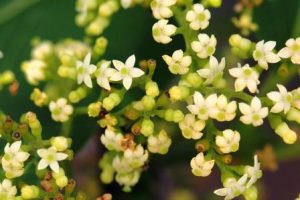
Canthium lactescens. Photo: Bart Wursten. Source: Flora of Zimbabwe
On the kalends of September seven Bulawayo Tree Society worthies went off to the west central Matopos down the Kezi road. An alluring site yielded numerous botanical genera in less time than their names could be recited and in an area occupying only a few square Canthium lactescens yards.
Nearby, a ring-necked dove turtled sung vigorously, while the mourning of an emerald spotted wood-dove wafted on the fitful breeze. The winter had been long, drear and tedious rather than exceptionally chilly, and cloudy drizzle persisted for dark dull day after dark dull day. Maybe as a result of the excellent rainfall, many trees were still reluctant to throw off their old foliage, although quite evidently new shoots were going to force the issue sooner rather than later.
The large leaves that still clung to Canthium lactescens provided conspicuous yellow splashes of colour. Erythrina latissima flaunted its spring scarlet. A stream still meandered crystal clear, and suddenly threw itself over what must be a spectacular waterfall when rain swells it.
Here I ran out of steam, and while the remainder of the outing progressed downstream, I sat under a bare, apparently lifeless Afzelia quanzensis and absorbed the beauty of the landscape. I also gathered the attractive black seeds with their bright red arils that the tree had strewn around liberally. I was joined by an extremely friendly group of local youngsters who gathered pocketfuls of these seeds, which they then poured into my plastic bag.
Only two Asclepiad plants were observed.
A Gomphocarpus, gorgeous in its pale flowers, and with a filigree of fresh green leaves, rose daintily from the riverbed below the waterfall. The remarkable seed horns of Orbeopsis caudata revealed its presence among fallen leaves beneath shrubby bushes. This Orbeopsis has strongly toothed grey stems, streaked with darker greys. They lurk beneath dried leaves, invisible to all except knowing eyes who seek them.
After lunch we explored the Euphorbia cooperi forest. Most of the trees were old, enormous and majestically dipped their lower branches in a splendid curving salute. There were several young trees, one of which was small enough to allow us to examine its strange cyathia and three-cornered fruit.
A medium sized plated lizard made a noisy and frenzied escape. Ripe fruits of Cucumis metuliferus gleamed bright orange. These fruits are heavily armed with sharp spines, to deter the most avid predator, for they are mostly edible.
Though the day had started cold, it became and remained warm, sunny and cloudless. The season of fires is upon us and smoke diffused the sunlight. On the way home it was delightful to see the sails of some small optimist craft on the Matopos dam, which once again holds sufficient water for them.
-Norma Hughes.
GOSHA PARK 15 SEPTEMBER 1996
Gosho Park is sandy Msasa woodland, with occasional, remarkably spectacular, rocky outcrops. Approximately 27 members and their friends arrived and we parked at a picnic site where there is a thatched building and a large board giving details of the Park. The altitude and rainfall are high, as the presence of such species as Bracken, Diospyros whyteana and Cussonia spicata, suggest. The Msasas themselves were in beautiful fresh green leaf and nearly all of them seemed to be flowering and filling the air with scent.
After a run of several hot days, we were expecting another hot day at Gosho Park. However, by the time we joined the queue at the entrance boom, where we signed in and attempted to stuff an envelope containing $15 through the very small hole in the tin, then began to regret having left jerseys behind. However, later it became pleasantly warm.
The first species which caught everyone’s attention was the white-flowered Sericanthe andongensis (known as Neorosea andongensis in the earlier edition of Coates Palgrave). This shrub was everywhere and was obviously unfamiliar to many members. The beautiful flowers were just appearing on generally leafless branches. Maureen pointed out how its 8 petals are slightly curved, giving the flower a Catherine-wheel appearance. The corolla tubes themselves are hairy on the back. The species is a member of the Rubiaceae with opposite leaves and interpetiolar stipules. In leaf it looks like a Tricalysia.
Diospyros whyteana was also very common. The leaves are a dark shiny green but have long hairs on the margins. In fruit the calyces expand to form a large inflated bladder-like structure enclosing the considerably smaller fruit and a number of these bladders were seen.
Gosho Park is a place where species occur in threes. Near the start of the walk near some rocks we immediately came across our first trio, namely a very spiny specimen of Maytenus heterophylla, small tree of Maytenus senegalensis and the rock-loving Maytenus undata. The latter has leaves which feel rather like plastic and when folded, a broad whitish marking is left on the leaf.
Amongst the rocks was a fine Ficus natalensis showing its characteristic truncate leaf apex. The tree was covered in a semi-parasite, namely Viscum menyhartii, a species of mistletoe. This species seems to be the commonest Viscum and in sheer volume it is certainly impressive, often festooning, and even sometimes killing, its host. The host of this species always seems to be a species of fig, although not necessarily Ficus natalensis.
Common everywhere were specimens of Apodytes dimidiata with its glossy dark-green leaves. This is another species usually of high rainfall areas. Near the cars were the first two of the three species of Cussonia, namely Cussonia arborea and Cussonia spicata. Walking through the woodland we came across Olinia vanguerioides. The specific name means ‘like a Vangueria’ and, indeed, it does have simple opposite leaves rather like a species of Rubiaceae, but apparently no stipules. I don’t know which species of Vangueria the author (E. G. Baker in 1911) had in mind when he named this species.
Shortly after lunch we climbed one of the rocky outcrops. A very interesting flora was present. Firstly, Maureen spotted the third Cussonia, i.e. Cussonia natalensis.
Another species typical of high rainfall areas, which even occurs in forest edges in the Eastern Districts, is Grewia stolzii. It is one of the few species of Grewia with white flowers. Its fruits are in 4s and have long dark brown hairs.
Sprawling amongst the rocky vegetation was Phytolacca dodecandra with its spikes of white flowers and slightly fleshy leaves.
After lunch, we set off through the woodland, crossed a still trickling stream and climbed up a rocky kopjie at the back of which were some Bushmen paintings. On the way we saw colonies of a tall white-flowered composite. The name was remembered wrongly by me at the time – apologies – it was in fact Ageratina adenophora (not Ageratinastrum which has not been recorded from Zimbabwe. It is an introduction, which is becoming quite common in disturbed places, although this is the first time I have seen it in flower. It is related, as the name suggests, to Ageratum, another commonly naturalized genus.
At the rocks, where Anthony Kaschula showed us the paintings of zebra, sable, kudu and bushmen, we once again found Phytolacca and a climbing species in the Asclepiadaceae which has paired fruits, Cryptolepis cryptolepioides. This is the species which is so common on the slopes of Domboshawa. On the way back to the cars, a small Euphorbia was found in the stream valley. This was Euphorbia cyparissioides, which has numerous linear leaves arranged around its stem. In a small clump of trees was a specimen of Vangueria randii.
All in all a beautiful day in some very lovely habitats. Our thanks go to Anthony for his help and for providing much interesting information about the Park.
-Mark Hyde
Urgently Required
Ann Bianchi is in desperate need of seeds of Diplorhynchus condylocarpon – the rubber tree. Please keep a look out for some and if successful send them (they are very light if taken out of their woody pod) to Ann at PO Box 2128 Harare, and we will see that she gets them.
MATABELELAND’S MONTHLY GATHERING
Was on 6th October and at Broughton Place in Douglasdale, the estate of Mrs. JA Bott which must owe much to the planting enthusiasm of its previous owner, Mrs. Clem Van Vliet, when the demesne was called Coriolanus.
Our group comprised solely five souls; is this a demo by absence of a death wish by the Matabeleland branch? Certainly a depressing fact, for it was a beautiful day with a light morning breeze and only scheduled for a half-day endurance. Broughton Place consists of a large well treed and watered kopjie garden, perched on the edge of a promontory with a splendid view to the east and north and complete with citrus plantation and a well ordered small nursery. Dropping off the promontory, you enter a sloping wild park with many indigenous species. In the garden proper we found many exotic trees planted by Clem before her conversion to the native genre and her joining the Tree Society!
Exotics included:
Hymenosporum flavum (in flower and seductive), Schizolobium parahyba (and why not), a genuine Gingko tree. Bombax ellipticum Bombacaceae, Croton sp. (Croton condylocarpon?); its oil gives you fulminating dysentery. Syzygium sp. (Syzygium legatii?), Ipomoea arborescens, Mexican apple (impressively fruitful). Brachychiton – several species. Acacia xanthophloea (not native to Matabeleland Central).
In the garden: (P) = planted
Anacardiaceae Rhus pyroides; Sclerocarya birrea; Lannea discolor;
Boraginaceae Ehretia rigida;
Celastraceae Crocoxylon transvaalense; Maytenus heterophylla;
Caesalpinioideae Peltophorum africanum;
Ebenaceae Euclea divinorum
Flacourtiaceae Dovyalis caffra; Flacourtia indica
Loganiaceae Strychnos spinosa
Mimosoideae Acacia karroo; Acacia nilotica; Acacia robusta ; Albizia amara
Moraceae Ficus abutilifolia (P); Ficus sur
Oleaceae Olea europaea Subsp. africana
Papilionaceae Erythrina lysistemon/caffra
Rhamnaceae Berchemia zeyheri; Ziziphus mucronata
Rubiaceae Calodendrum capense
Sapotaceae Mimusops zeyheri
Sapindaceae Pappea capensis
Sterculiaceae Dombeya rotundifolia
Ulmaceae Celtis africana
Verbenaceae Clerodendrum glabrum
In the wilder indigenous area:
Anacardiaceae Lannea edulis (in ripe fruit)
Rhus tenuinervis
Apocynaceae Carissa edulis (jasmine scent)
Bombacaceae Adansonia digitata (P 3 years ago)
Combretaceae Combretum apiculatum
Combretum hereroense
Combretum molle
Ebenaceae Diospyros lycioides
Euclea divinorum
Euphorbiaceae Euphorbia ingens
Flueggea virosa
Spirostachys africana (P)
Meliaceae Turraea nilotica (in flower and green fruit)
Mimosoideae Acacia gerrardii
Acacia robusta
Albizia antunesiana
Albizia amara
Moraceae Ficus sur
Ficus thonningii
Papilionoideae Ormocarpum trichocarpum (in flower)
Proteaceae Faurea saligna
Protea gaguedi (in flower)
Rubiaceae Canthium lactescens
Tiliaceae Grewia flavescens
We set off for home, circa 12km around noon. With many thanks to Mrs. Bott for showing us her park and for her tea.
-Eric McNair
ANDY MACNAUGHTAN CHAIRMAN


